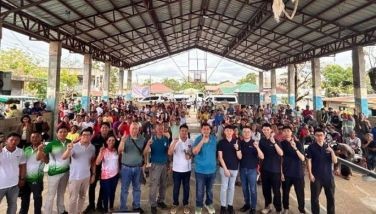Road space

There is another preventable calamity unfolding before our eyes right here in the metropolitan area. It unfolds, literally, in slow motion.
This time of the year, traffic is usually heavy. This year, it is unbearably gnarled.
Since last week, moving from one point in the city to another has become a form of torture. Travel time has at least doubled in the main routes. Billions are lost each day in fuel needlessly burned, productivity lost and nerves frayed.
We might as well declare a state of calamity in the capital region. If people and goods could not be moved, the economy is choked.
The only time traffic flow was bearable happened midday Sunday as everyone stopped to watch that great fight between Pacquiao and Marquez. The sad outcome of the event, however, gave us no consolation.
Traffic in the capital region is a textbook case in government failure.
The most basic cause of the paralysis in movement is the gross disparity between available road space and the number of vehicles that available road space carries. Government might have addressed that disparity either by restricting the number of vehicles using the roads or by dramatically increasing road space.
Government did neither.
In fact, the mystifying proliferation of “colorum” public transport, remains unchecked. Sequestering illegal buses and jeepneys seems like a fairly simple thing to do. For some reason, through all the years, this has not been done.
Construction of the Slex-Nlex overhead link road is an obvious solution to ridding the city’s streets of traffic load traversing from south to north. That link road is stalled for some reason — mainly, it seems, official indecision.
The construction of the C-6 road on the eastern side of the metropolis should likewise ease the load now carried by C-5. That road remains largely on the drawing board.
The C-5 road is supposed to cut through from Quezon City to Navotas. That road is still disconnected. For that matter, the C-3 road is cut in Caloocan due to unresolved right-of-way issues.
The circumferential road proposed to be built around Laguna de Bay as part of the Belgian-supported dredging of this problematic lake might have helped greatly in moving traffic in the now heavily populated areas south and east of the city. That project was scrapped.
The LRT-MRT loop was completed over three years ago. While the rail connection is complete, the integration of the two lines has yet to be done. This is a great mystery only the DOTC can explain. That interconnection should ease movement of people from Monumento to North Avenue.
The new rail line from North Avenue to San Jose del Monte has been on the drawing board for a generation now as the population of the Payatas-Fairview area booms. Again, for some reason known only to the DOTC, no work has commenced on this line.
Meanwhile, LRT1 and the MRT are barely operable. Because of poor maintenance, the trains break down with regularity, stranding tens of thousands of commuters.
To cope with the commuter load, both lines have to add trains to shorten waiting time during rush hours or add wagons to the trains, which the existing stations could accommodate. Neither has been done.
Instead, the existing capacity is allowed to carry nearly twice the passenger load it is designed for. This is a dangerous thing. Instead of being a public convenience, these two lines become a public hazard.
Four years ago, when the GFIs took economic control of the MRT, the management pointed out that the wagon wheels were seriously worn out and needed replacement. The worn out wheels are the reason the trains sway like a pendulum in transit. The last time I took the MRT, it is obvious those overused wheels have not been replaced. There is a disaster here waiting to happen.
In the city of Manila, pedicabs are allowed to compete for road space in the main arteries. That clogs up movement of all vehicles.
There should be about ten thousand junk vehicles dumped on the public space all throughout the metropolis. There should be a program to collect all these irresponsibly abandoned junk so that they may be melted into usable steel.
Jeepney operators should be required to maintain garages. So many kilometers of road space are consumed by jeepneys parked on the roads.
Whatever happened to the plan to use the Pasig River as a transport channel, moving heavy containers using barges instead of trucking the cargo down congested city roads? Will somebody please revisit this plan?
In Bangkok, the river ferries are part of a seamless web along with the subways, the light rail and the bus routes. A unified ticketing system links all of them with a minimum of inconvenience to the riding public. We could do that too if our urban transport management has enough wit and enough will.
Last week, the authorities announced the truck ban will be temporarily expanded to help ease traffic flow during the holidays. That measure, clearly, helped very little.
We need a comprehensive infra plan to be rushed into place to contain what is truly a calamity. So far, the only piece of infra put in place during this administration is that small underpass on the junction of Quezon and Araneta avenues.
That will not suffice, obviously. There is a traffic crisis gripping the metropolis. It must be approached as such.
- Latest
- Trending























